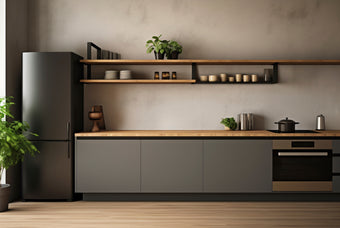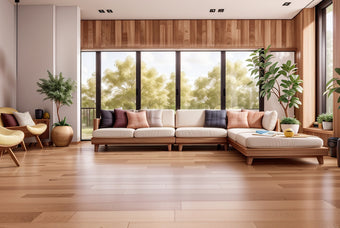Most popular
Flooring - essential for any building or space:
Flooring is an essential aspect of any building or space, whether it is a residential, commercial, or industrial setting. It serves as the foundation for interior design and plays a significant role in the overall aesthetics and functionality of a space. Choosing the right flooring material for your needs is crucial. There are various options available, each with its own unique characteristics, advantages, and considerations. Some popular flooring materials include hardwood, laminate, vinyl, carpet, tile, and concrete.
1) Hardwood flooring is an elegant choice known for its durability and longevity and can be refinished multiple times to maintain its appearance.
2) Laminate flooring is a cost-effective alternative to hardwood, replicating its look with a multi-layer synthetic material that is easy to install and maintain.
3) Vinyl flooring is highly versatile and available in a wide range of designs, patterns, and colors. It is durable and moisture-resistant.
4) Carpet flooring provides comfort, insulation, and sound absorption, making it ideal for bedrooms and living areas.
5) Tile flooring, including ceramic, porcelain, and natural stone options, offers durability and versatility. Used in kitchens, bathrooms, and high-traffic areas due to its resistance to moisture and wear.
When selecting a flooring material, it is important to consider factors such as durability, aesthetics, ease of maintenance, cost, and installation requirements. Consulting with a professional flooring expert can help you make an informed decision based on your specific needs and preferences. Proper installation and maintenance are essential to ensure the longevity and performance of your flooring.
In conclusion, flooring is an integral part of any space and offers both functional and aesthetic benefits. With a wide range of materials and options available, it is important to carefully consider your needs and consult with professionals to select the right flooring material and ensure proper installation and maintenance.
Mastering Vinyl Flooring: Uncovering Its Multilayered Structure:
Vinyl flooring is a synthetic flooring material that is known for its durability, versatility, and affordability. It is a popular choice for many residential and commercial spaces due to its ability to mimic the look of natural materials such as wood or stone. When it comes to the layers of vinyl flooring, it typically consists of four main layers. The first layer is the wear layer, which is a transparent protective layer that helps to shield the flooring from scratches, stains, and wear and tear. This layer is crucial in determining the durability and longevity of the vinyl flooring.
The second layer is the printed layer, also known as the design layer. This layer is responsible for giving the vinyl flooring its desired appearance, whether it be a wood grain pattern, a stone texture, or any other design. With advances in technology, vinyl flooring can now replicate the look and feel of natural materials with remarkable accuracy. Below the printed layer is the core layer, which provides stability and strength to the flooring. This layer is usually made from a composite of materials such as PVC, limestone, and fiberglass. The core layer also plays a significant role in the overall quality and performance of the vinyl flooring.
Lastly, the bottom layer is the backing layer, which serves as a moisture barrier and helps to prevent the growth of mold and mildew. This layer is usually made from materials like felt or cork, providing additional insulation and noise reduction. Overall, vinyl flooring is a multi-layered material that combines various components to create a durable and attractive flooring option. By understanding the different layers and their functions, you can make an informed decision when choosing vinyl flooring for your space.

Tips for installing vinyl plank flooring:
Installing vinyl flooring can be a great way to update the look of your space while providing durability and easy maintenance. Whether you're a professional contractor or a DIY enthusiast, there are several key considerations to keep in mind when installing vinyl floors. First, you'll need to gather the necessary tools and materials. It's important to choose a high-quality vinyl flooring product that suits your needs and matches the style of your space. Ensure that the subfloor is clean, flat, and free of any debris. Additionally, it's crucial to check for moisture in the subfloor, as excess moisture can cause damage to the vinyl flooring over time.
Once the subfloor is ready, it's time to lay down the vinyl flooring. Start by measuring the space and cutting the vinyl into the desired lengths. It's important to leave a small gap, usually around 1/8 inch, between the edges of the vinyl and the wall to allow for expansion. Apply adhesive to the subfloor using a trowel, following the manufacturer's instructions. Lay the vinyl down carefully, making sure to press it firmly into the adhesive to ensure a secure bond. After the vinyl is installed, use a roller to go over the entire surface to ensure proper adhesion and eliminate any air bubbles. Pay special attention to seams and edges, as these areas can be prone to lifting if not properly secured.
Once the vinyl flooring is in place, it's important to take proper care of it to ensure its longevity. Avoid dragging heavy furniture across the floor, as this can cause scratches. Additionally, be mindful of sharp objects that could potentially puncture the vinyl. Regularly sweep or vacuum the floor to remove dirt and debris, and clean up any spills or stains promptly using a mild cleaner recommended for vinyl floors. In conclusion, installing vinyl flooring can be a straightforward process if you follow the necessary steps and consider important factors such as subfloor preparation, adhesive application, and proper maintenance. Taking the time to properly install and care for your vinyl floors will ensure a beautiful and long-lasting addition to your space.

Advantages & Disadvantages of Vinyl Flooring:
Vinyl flooring has gained popularity in recent years due to its durability, versatility, and ease of maintenance. However, like any flooring option, it has its advantages and disadvantages that should be considered before making a decision.
Advantages of Vinyl Flooring:
-
Durability: Vinyl flooring is known for its exceptional durability, making it a great choice for high-traffic areas such as hallways, kitchens, and bathrooms. It is resistant to scratches, dents, stains, and moisture, making it suitable for homes with pets and children.
-
Versatility: Vinyl flooring comes in a wide range of colors, patterns, and styles, allowing you to achieve the look of ceramic tiles, hardwood, or stone without the high cost and maintenance. It can easily mimic the appearance of natural materials, giving your space a sophisticated and luxurious feel.
-
Easy Maintenance: Vinyl flooring is incredibly easy to clean and maintain. Regular sweeping or vacuuming, along with occasional mopping using a mild cleaner, is usually sufficient to keep it looking pristine. Unlike other flooring options, vinyl does not require waxing, polishing, or refinishing.
-
Comfort: Vinyl flooring has a cushioned layer that provides a more comfortable feel underfoot, reducing leg fatigue and offering a softer surface compared to hardwood or tile. This makes it a popular choice for areas where prolonged standing or walking is common, such as kitchens or laundry rooms.
Disadvantages of Vinyl Flooring:
-
Environmental Concerns: Vinyl flooring is made from polyvinyl chloride (PVC), which raises environmental concerns. PVC production and disposal contribute to the release of toxic chemicals and the depletion of natural resources. However, eco-friendly and sustainable vinyl options are available, which use alternative materials and manufacturing processes.
-
Susceptibility to Heat and Sunlight: Vinyl flooring can be sensitive to extreme heat, causing it to warp or fade if exposed to direct sunlight or hot objects. Therefore, it may not be suitable for outdoor areas, rooms with large windows, or spaces that have high exposure to heat sources.
-
Limited Repair Options: While vinyl flooring is durable, it is not immune to damage. If a section of vinyl flooring gets damaged, it is difficult to replace or repair a single tile or plank without affecting the surrounding area. This means that significant damage may require replacing an entire section or even the entire floor.
-
Reduced Resale Value: Vinyl flooring, although practical and attractive, may not have the same perceived value as natural materials like hardwood or ceramic tiles. If resale value is a significant factor for you, it may be worth exploring other flooring options that are more highly regarded in the real estate market.
It is essential to weigh the advantages and disadvantages of vinyl flooring against your specific needs, budget, and preferences. Consulting with a flooring professional can provide valuable insights and help you make an informed decision.
Enhancing Your Home's Aesthetics with Vinyl Flooring's Diverse Styles:
When it comes to vinyl flooring, there are numerous options available in terms of appearance, design, and variety. Vinyl flooring has come a long way in terms of aesthetics and can now mimic the appearance of different materials such as hardwood, stone, and tile. This allows you to achieve the look you desire in your space without the added cost and maintenance associated with these natural materials. In terms of design, vinyl flooring is available in a wide array of patterns, colors, and textures. Whether you prefer a traditional, contemporary, or eclectic style, there is a vinyl flooring option that will complement your design scheme.

In addition to appearance and design, vinyl flooring also offers several varieties to choose from. Traditional vinyl flooring is known as sheet vinyl this type of vinyl flooring is affordable and easy to install, making it a popular choice for many homeowners and businesses alike. Another popular variety of vinyl flooring is luxury vinyl plank (LVP) and luxury vinyl tile (LVT). LVP and LVT are individual planks or tiles that can be installed with adhesive or a click-lock system. These varieties of vinyl flooring provide a more realistic look and feel, with textured surfaces that mimic the graining of hardwood or the texture of natural stone. LVP and LVT offer enhanced durability and resistance to moisture, making them ideal for high-traffic areas and spaces prone to spills and moisture.
Explore Our Vinyl Flooring Collection Now!
Empty content. Please select category to preview
Join our newsletter now
Promotions, new products and sales. Directly to your inbox.





